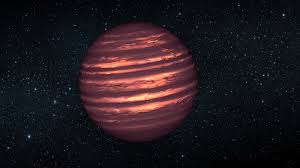Brown Dwarfs : Study

Researchers have used James Webb Space Telescope observations to conduct detailed examinations of the atmospheric conditions on pairs of brown dwarfs.
- Brown dwarfs are celestial bodies bigger than a planet but smaller than a star
- These objects have a size between that of a giant planet like Jupiter and that of a small star.
- Brown dwarfs accumulate material like a star, not like a planet.
- They can also have clouds made out of precipitates in their atmospheres. However, while we have water clouds on Earth, the clouds on brown dwarfs are much hotter and likely made up of hot silicate particles.
- Thus, they hold onto their lighter elements (hydrogen and helium) more effectively than planets and have a relatively low metal content.
- However, brown dwarfs do not have enough mass for their cores to burn nuclear fuel and radiate starlight. This is why they are sometimes referred to as “failed stars.”
James Webb Space Telescope:
- It was launched in 2021 as a joint endeavour of the USA, European and Canadian space agencies.
- It is a large infrared telescope with an approximately 6.5 meter primary mirror.
- It does not orbit around the Earth like the Hubble Space Telescope; it orbits the Sun 5 million kilometers away from the Earth at what is called the second Lagrange point or L2.




